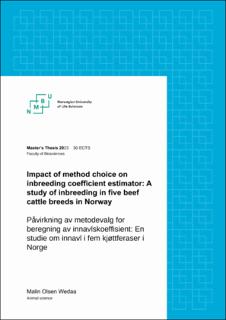| dc.description.abstract | In 2020 was genotyping implemented into the populations of Norwegian beef cattle breeds of Hereford, Charolais, Aberdeen Angus, Limousin and Simmental. This development provides an opportunity to estimate genomic inbreeding within the population of these Norwegian beef cattle breeds.
Various methods were used for estimating inbreeding coefficients, including FVanRaden1, Fhom, Funi, FROH and Fped. When inbreeding is defined as identical-by-decent, estimators must range between 0 and 1 since they estimate probability (FROH and Fped). In contrast, when inbreeding is defined as the correlation between uniting gametes, estimators can take both positive and negative values ranging from -1 to 1 (FVanRaden1, Fhom, Funi). The software tools PLINK.v1.9, CFC and R-studio has been used for conducting the estimates. Two approaches of analyzes for FVanRaden1, Fhom, Funi, FROH in PLINK.v1.9 has been used. The first involved separate analysis by breeds, followed by a second approach where dataset contained all breeds, but each breed was coded as a family, and post-analysis was the breeds separate into individual datasets. The two approaches gave different estimates from FVanRaden1, Fhom, Funi, suggesting that the methods are sensitive to the reference allele frequencies. Correlations within methods conducted in the two approaches reveals that FVanRaden1 showed to have the lowest correlation with itself. FROH had a perfect correlation and are only influenced by the fit of parameter settings.
Mean inbreeding coefficient showed to be lower than estimates from populations from other countries. The results from Fped analysis in this study align closely with the finding of Kleiven (2007) for the same Norwegian beef cattle breeds in 2006. This could be explained with a substantial import of genetic material from outside Norway.
FROH divided the breeds into two groups where Hereford, Charolais and Aberdeen Angus all had an inbreeding of ~12% and Limousin and Simmental had an inbreeding of 4% and 5% respectively.
Research has consistently shown the complexity of selecting an appropriate inbreeding coefficient, and this complexity is also evident in this study. However, the study highlights the advantages of using FROH, which is not sensitive to reference allele frequencies, allows for breed comparisons, and can differentiate between new and old inbreeding. | |
